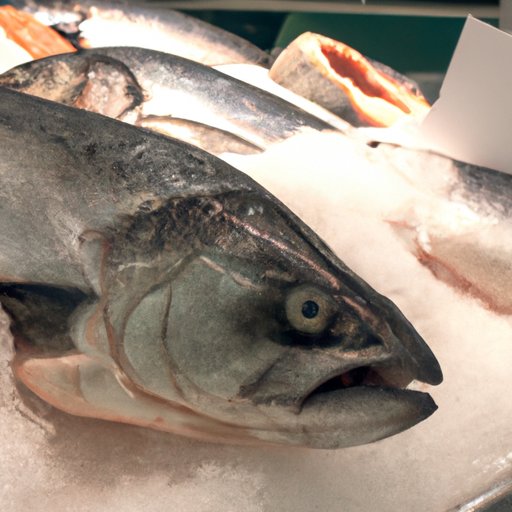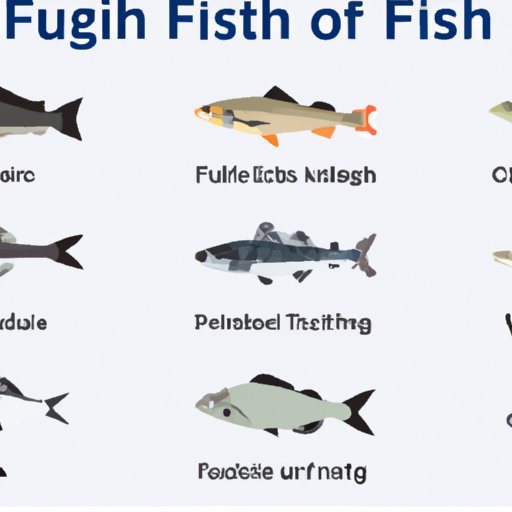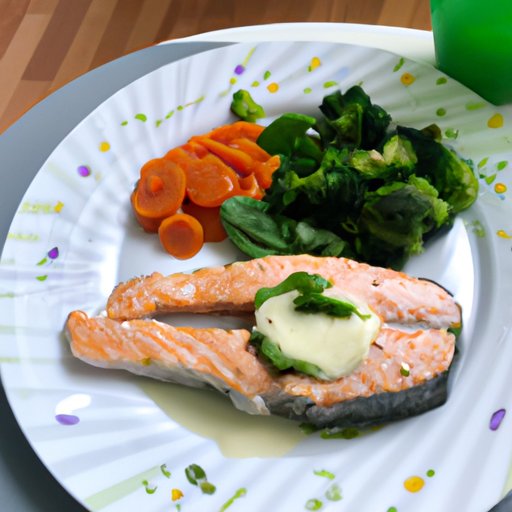Introduction
Fish is an excellent source of protein, vitamins, and minerals that can be beneficial to your health. Eating fish on a regular basis has been linked to improved heart health, brain function, and overall wellbeing. With so many different types of fish available, it can be difficult to know which one is best for you. This article will explore the different types of fish, their nutritional benefits, and the most sustainable seafood options. We’ll also provide some recipes and meal ideas to help you incorporate more fish into your diet.
A Comparison of the Nutritional Benefits of Different Types of Fish
All types of fish contain a variety of essential nutrients, but some are particularly high in certain vitamins and minerals. For example, salmon is an excellent source of omega-3 fatty acids, while tuna is packed with protein. It’s important to understand the nutritional differences between different types of fish so you can make the best choice for your health. Let’s take a look at some of the key nutrients found in fish:
Omega-3 Fatty Acids
Omega-3 fatty acids are essential fatty acids that play an important role in brain health, heart health, and inflammation. Studies have suggested that consuming adequate amounts of omega-3 fatty acids may reduce the risk of heart disease, stroke, and other health conditions. The best sources of omega-3 fatty acids are fatty fish such as salmon, mackerel, sardines, and herring. A 3-ounce serving of salmon contains about 2.5 grams of omega-3 fatty acids.
Protein Content
Fish is an excellent source of high-quality protein, which is essential for muscle growth and repair. Tuna is particularly high in protein, with a 3-ounce serving containing about 20 grams of protein. Other fish that are high in protein include salmon, cod, halibut, and catfish. Protein is an important nutrient for athletes, bodybuilders, and anyone looking to build muscle or lose weight.
Vitamins and Minerals
Fish is also a good source of several vitamins and minerals. It’s particularly high in vitamin B12, selenium, and phosphorus. It also contains smaller amounts of other vitamins and minerals, such as zinc, magnesium, and potassium. These nutrients are essential for a variety of bodily functions, from metabolism to immune system health.
The Healthiest Fishes for a Balanced Diet
When choosing fish for a balanced diet, there are several factors to consider. The type of fish, the cut, and the preparation method all play a role in determining the nutritional value of the dish. Here are some of the healthiest fishes for a balanced diet:
Salmon
Salmon is one of the most nutritious types of fish. It’s an excellent source of omega-3 fatty acids, protein, and vitamins and minerals. Wild-caught salmon is the best option, as farmed salmon is often fed a diet of grains and soy, which can decrease its nutritional value. Salmon can be prepared in a variety of ways, including baking, grilling, and poaching.
Tuna
Tuna is another excellent source of omega-3 fatty acids and protein. It’s low in calories and fat, making it a great choice for those trying to lose weight. Canned tuna is an affordable and convenient option, but fresh or frozen tuna is usually higher in omega-3 fatty acids. Tuna can be prepared in a variety of ways, including grilling, baking, and searing.
Mackerel
Mackerel is a fatty fish that is high in omega-3 fatty acids. It’s also an excellent source of protein and vitamins and minerals. Mackerel can be prepared in a variety of ways, including grilling, baking, and poaching. However, it’s important to note that mackerel has a strong flavor, so it may not be to everyone’s taste.
Sardines
Sardines are small, oily fish that are high in omega-3 fatty acids and protein. They’re also an excellent source of vitamins and minerals, including calcium, iron, and vitamin D. Sardines can be eaten fresh or canned, and they can be prepared in a variety of ways, such as grilling, baking, and pan-frying.
Trout
Trout is a freshwater fish that is high in protein and omega-3 fatty acids. It’s also a good source of vitamins and minerals, such as iron and vitamin B12. Trout can be prepared in a variety of ways, including baking, grilling, and poaching. It’s important to note that trout can contain mercury, so it’s best to limit your intake to two servings per week.
Herring
Herring is an oily fish that is high in omega-3 fatty acids. It’s also a good source of protein and vitamins and minerals. Herring can be eaten fresh or canned, and it can be prepared in a variety of ways, such as grilling, baking, and pan-frying. Like mackerel, herring has a strong flavor, so it may not be to everyone’s taste.

Exploring the Different Cuts and Preparations of Fish
When preparing fish, it’s important to choose the right cut and preparation method. Different cuts and preparations can affect the nutritional value of the dish. Here are some things to keep in mind when preparing fish:
Fresh vs. Frozen Fish
Fresh fish is generally considered to be more nutritious than frozen fish, as freezing can cause some of the nutrients to degrade over time. When choosing fresh fish, look for fish that is firm, shiny, and odorless. If you’re buying frozen fish, make sure it’s been properly stored and has no signs of freezer burn.
Whole vs. Fillets
When buying whole fish, it’s important to check for any signs of spoilage, such as discoloration or a foul odor. Whole fish is usually more nutritious than fillets, as it contains the bones and organs, which are rich in vitamins and minerals. However, fillets are usually easier to prepare and cook.
Smoked, Cured, or Pickled
Smoked, cured, or pickled fish can be a tasty way to enjoy fish, but these methods can also lead to a loss of nutrients. Additionally, these preparation methods often involve added salt, sugar, and fat, which can increase the calorie and sodium content of the dish. If you’re looking for a healthier option, opt for fresh or frozen fish that is baked, grilled, or poached.

Sustainable Seafood: What to Look For When Buying Fish
When shopping for fish, it’s important to look for sustainable seafood options. Overfishing and fishing practices that harm marine ecosystems can lead to a decline in wild fish populations. To ensure you’re supporting sustainable fisheries, look for certification labels such as Marine Stewardship Council (MSC) or Friend of the Sea (FOS). Additionally, look for local and seasonal options, as these are usually the freshest and most sustainable.

A Guide to the Most Popular Types of Fish
Fish is an incredibly versatile ingredient that can be used in a variety of dishes. Here’s a guide to some of the most popular types of fish:
Tilapia
Tilapia is a mild-flavored white fish that is low in calories and fat. It’s often used in fish tacos, fish sandwiches, and fish stews. Tilapia can be prepared in a variety of ways, such as baking, grilling, and frying.
Cod
Cod is a flaky white fish that is mild in flavor. It’s often used in fish and chips, chowders, and fish cakes. Cod can be prepared in a variety of ways, such as baking, grilling, and poaching.
Halibut
Halibut is a firm white fish that is mild in flavor. It’s often used in fish tacos, fish sandwiches, and fish stews. Halibut can be prepared in a variety of ways, such as baking, grilling, and poaching.
Catfish
Catfish is a mild-flavored white fish that is low in calories and fat. It’s often used in fish tacos, fish sandwiches, and fish stews. Catfish can be prepared in a variety of ways, such as baking, grilling, and frying.
Shrimp
Shrimp is a popular shellfish that is low in calories and high in protein. It’s often used in stir-fries, salads, and pasta dishes. Shrimp can be prepared in a variety of ways, such as baking, grilling, and sautéing.

Healthy Eating with Fish: Recipes and Meal Ideas
Eating fish can be a delicious and nutritious way to get the nutrients your body needs. Here are some recipes and meal ideas to help you incorporate more fish into your diet:
Main Dishes
Grilled Salmon with Asparagus and Lemon:
Baked Cod with Tomatoes and Olives:
Tuna Poke Bowl:
Grilled Mackerel with Garlic and Herbs:
Sardine Pasta Salad:
Pan-Fried Trout with Spinach and Potatoes:
Sides
Crispy Baked Fish Sticks:
Coconut Rice with Shrimp:
Roasted Brussels Sprouts with Salmon:
Quinoa Pilaf with Cod:
Cauliflower Mash with Smoked Salmon:
Sweet Potato Wedges with Herring:
Salads
Tuna Nicoise Salad:
Kale Salad with Grilled Salmon:
Thai Shrimp Salad:
Mediterranean Tuna Salad:
Cucumber and Tomato Salad with Mackerel:
Quinoa and Avocado Salad with Trout:
The Best Fish for Your Budget: Affordable Options for Healthy Eating
Eating fish doesn’t have to be expensive. There are plenty of budget-friendly options that can provide you with the nutrients your body needs. Here are some tips for finding the best fish for your budget:
Commonly Used Fish
Look for commonly used fish, such as tilapia, cod, and catfish. These types of fish are usually less expensive than other varieties and can be prepared in a variety of ways. Additionally, frozen fish is usually cheaper than fresh and can be just as nutritious.
Lesser Known Fish
Don’t be afraid to try lesser known fish, such as herring, sardines, or mackerel. These types of fish are usually lower in price than more popular varieties, but they can still provide a wealth of nutrition. Additionally, these types of fish are often sustainably sourced, so you can feel good about your purchase.
Inexpensive Preparation Methods
Preparing fish in an inexpensive way can help keep costs down. Baking, grilling, and poaching are all great methods that don’t require a lot of additional ingredients. Additionally, adding vegetables to your dish can help bulk it up without breaking the bank.
Conclusion
Fish is an excellent source of protein, vitamins, and minerals that can be beneficial to your health. With so many different types of fish available, it can be difficult to know which one is best for you. This article explored the different types of fish, their nutritional benefits, and the most sustainable seafood options. We also provided some recipes and meal ideas to help you incorporate more fish into your diet. Remember to look for sustainable seafood options and to choose the right cut and preparation method for the most nutritional value. Eating fish can be a delicious and nutritious way to get the nutrients your body needs.
(Note: Is this article not meeting your expectations? Do you have knowledge or insights to share? Unlock new opportunities and expand your reach by joining our authors team. Click Registration to join us and share your expertise with our readers.)
